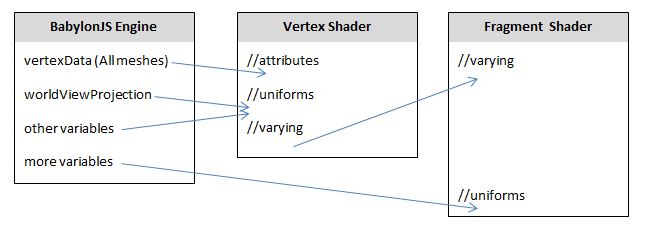Overview
Introduction to Shaders in BabylonJS
A shader is a program processed by the Graphical Processing Unit (GPU) to produce a screen image by manipulating data to produce individual pixels. The GPU is optimised, through parallel processing, to deal with these thousand of operations in an extremely fast way.
Suggested Pre-Reading
Custom Meshes
Normals in BJS
Updating Vertices
An Overview
Basic
To produce a BabylonJS scene, code is written in Javascript which the BabylonJS Engine processes and displays the result on screen. The scene can alter through changes to the meshes, the lights or camera position. To show possible changes in a timely way the screen display (frame) is re-drawn up to 60 frames per second.
Simplifying, the process is
- Scene Code is processed in the CPU by the BJS Engine Code to produce a Virtual 3D Model
- Virtual 3D Model is processed in the CPU by the BJS Engine Code to produce Shader GPU Code
- Shader GPU Code is processed by GPU to produce screen image.
For example the BabylonJS Engine takes this code
var box = BABYLON.MeshBuilder.CreateBox("box", {}, scene);
and turns it into vertex data including positions, colors and normals
The BabylonJS Engine creates the shader code for this data and is passed to the GPU.
Custom
Much more than this as well as Scene Code you can write your own user Shader Code so that the process becomes
- Scene Code is processed in the CPU by the BJS Engine Code to produce a Virtual 3D Model
- Virtual 3D Model and User Shader Code is processed in the CPU by the BJS Engine Code to produce the Shader GPU Code
- Shader GPU Code is processed by GPU to produce the screen image.
Types of Shader
Shaders are written in Graphics Library Shader Language (GLSL) and come in two parts.
Vertex Shader - this takes the data for each vetex and determines where on the screen the pixel for it will be displayed and its color.
Fragment Shader - this uses data from the Vertex Shader to determine the position and colour of the pixels to represent each facet of the mesh.
Fragement Shaders are sometimes refered to as Pixel Shaders.

Passing Variables
The vertex data for position, normal and uv coordinates are passed to the Vertex Shader as variables of category attribute. User data can be passed to both the Vertex Shader and the Fragment Shader as variables of category uniform. Data can be passed from the Vertex Shader to the Fragment Shader with variables of category varying.
A vital uniform variable to declare in the Vertex Shader is worldViewProjection as the BabylonJS Engine uses this to pass scene 3D - 2D projection data to the Vertex Shader.

Variable types
All variables used in both shaders must be given a type and any numbers assigned to the variable must be consistent with its type.
For example
int n = 2;
float r = 2.0;
The following example with throw an error
float r = 2;
Some examples of types are
vec2 ------ a two dimensional vector of floating-point numbers
vec3 ------ a three dimensional vector of floating-point numbers
mat4 ------ a matrix with 4 columns and 4 rows floating-point numbers
sampler2D - a 2D texture image
Since vertex positions need to be as accurate as possible all floating-point numbers should be set as having high precision. This is done at the start of the code for each shader using -
precision highp float
Built In Variables
The GLSL language has a number of built in variables. Two are vital to the operation of the two shaders and are always neceesary.
gl_Position which provides positional data for screen coordinates
gl_FragColor which provides colour data for the representation of a facet on screen.
Functions
Functions needed to be typed as do their parameters and have the form
float NAME(typed parameters) {
*code*
}
Running Shader Code
Both the Vertex and the Fragment Shader are run from a function which must be called main and be of type void since it returns no result. It must also must type the empty parameter list as void.
void main(void) {
*code*
}

Putting Shader Code in BabylonJS
Here are four ways of putting shader code into your scene:
- Use BabylonJS Create Your Own Shader (CYOS) and download a zip file;
- Write the Vertex and Fragment Shader Code into <script> tags
- Write, save and import a Vertex and Fragment Shader file of type .fx into your code;
- Use the shaderBuilder extension of BabylonJS.
More details on this can be found below.